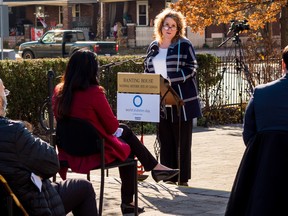Galas go virtual: how charities maintain the giving momentum
Sustaining relationships with loyal donors in a Zoom era means being extra creative

Article content
As the COVID-19 pandemic put a sudden stop to the hotel rooms brimming with lush floral arrangements and high-society guests in designer gowns sipping champagne, the charities relying on these gala events to raise desperately needed funds had to pivot on a dime.
Last year, and again in 2021, organizers are coming up with creative ideas to entertain patrons used to lavish affairs.
For instance, Sotheby’s partnered with Google last year in support of International Rescue Committee with a charity event auctioning off experiences ranging from coffee with Hillary Clinton to a Shakespearean acting class with Sir Patrick Stewart, a chance to sing with Sting or a private call with an astronaut, among other things.
Ottawa’s Canadian Tire Snowsuit Fund Gala last year featured a Gala-In-A-Box delivered to patrons, which included a 4-course gourmet meal, a Signature Snowsuit Cosmo Cocktail and bespoke gifts, such as bedazzled toques.
And the Women’s Foundation in Hong Kong featured a luxury draw that included a Christian Louboutin “Paloma Love” handbag, then valued at about $2,870.
But they are a far cry from what photographer and philanthropist Tamara Bahry remembers as the greatest fundraising gala events she both planned and attended for many years pre-COVID.
The new reality
“The room would be filled with patrons of the arts, journalists, philanthropists, prominent figures of society, ambassadors of the charitable organizations, and fashionistas,” said Bahry, who is also the director of the Human Anti-Trafficking Response Team (HART). “All [would be] current or potential donors who could also help raise awareness for the cause.”
But now, those who devote their time and careers to raising money for some of the country’s most important causes have had to get creative in a scene that’s been radically redesigned in the wake of a global pandemic. And among their challenges is the difficulty some of the older, wealthy generation have in navigating digital communication.
A shift from festive décor is just one of endless changes that have had to be made since the outbreak of COVID, and major organizations have risen to the challenge of not only attracting new donations, but also maintaining relationships with loyal, sometimes decades-long major donors.
“Before the pandemic, attending this gala was the highlight of the Black community’s social season,” said Nadine Spencer, president of the Black Business and Professional Association, specifically recalling the BBPA’s Harry Jerome Awards, which is their principal fund-raising gala and is due to celebrate its 40th anniversary next year. “Invited would be all of the leaders of the community, including people from politics, the arts, music, business, sports and civic action. I do hope these times soon come again. The room was always very festive.”
Also celebrating a milestone are JDRF Canada (formerly Juvenile Diabetes Research Fund) and Diabetes Canada, with the 100th anniversary of the discovery of insulin. These important anniversaries have put experts to the test over the course of the past year’s fundraising planning. Like the rest of the business and education world, all interaction has gone digital, and initiatives have had to evolve.
Cocktail kits and sweating from home
“Our fundraising events have still found unique ways to engage the audience, even if they’re tuning in from the comfort of their own home,” said Dave Prowten, JDRF Canada’s president and CEO.
“Our gala in B.C. delivered gourmet meals and cocktail kits to attendees. Our virtual ‘House ParT1D’ featured many celebrity guests and allowed people to fundraise and chat with each other in real time. Our Sun Life Ride to Defeat Diabetes gave people the option of spinning, sweating or stretching from home with a class led by a fitness instructor, and this year, our Sun Life Walk to Cure Diabetes is asking people to walk 100 kilometres to mark 100 years since the discovery of insulin before they meet us at the online finish line.”
While outdoor, community-accessible events that can be socially distanced have been a hit, the missing familiarity of a lavish social gala has been trying on other circles where longer-term, larger donors have struggled to maintain connection.
“Galas, education conferences, golf tournaments, etc., were postponed or moved online, having a huge impact on our ability to not only attract attendees but sponsors as well,” said Laura Syron, president and CEO of Diabetes Canada. “We’ve also seen many of our corporate donors take a step back as they concentrate on keeping their own businesses moving ahead successfully. In fundraising, building personal relationships with our donors is critically important and that has become much more challenging in a world of Zoom teleconferences instead of face-to-face meetings.”
On the positive side, the forced changes have shown the organization how much greater its capacity for outreach can be, Syron adds. In May it reached more than 1,200 health-care professionals across the country with a large online gathering, and digital events often feature strong return on investment because costs are so much lower than hosting a large, in-person event.
Older, loyal generations of donors have been quick to adapt to the digital era despite some hesitation or anxiety along the way.
“I would say it has been a transition,” said Bahry, whose HART has partnered with Women’s College Hospital to launch new research and expand outreach to interested donors. “This is particularly true of long-standing patrons who may not be as current with social media. It can be harder to connect as much as you’d like on an interpersonal level.”
This can result in long-term donors using other channels to donate, said Syron.
‘We’re all in this together’
On the other hand, “We have also seen many lapsed donors renew their support. We have very much seen a spirit of ‘we’re all in this together.’”
At SickKids Foundation, the spirit has had to move mountains. When the pandemic hit, the Hospital for Sick Children in Toronto was in the midst of a massive campaign – the SickKids VS Limits campaign, which aims to raise $1.3 billion. Fundraising imperatives include building a new hospital, funding continuing pediatric research and establishing partnerships for better patient care.
“Of course, at the beginning, it was difficult,” said Seanna Millar, senior vice-president, corporate and community partnerships, at the SickKids Foundation. “Major gift donors were used to meeting with us face to face. Live in-person events, such as our fundraising walk, SickKids GetLoud, couldn’t take place in the usual way. Door-to-door canvassing and mall monthly donor programs had to shift and change as more restrictions were put in place.”
Instead, SickKids GetLoud became a month-long activity challenge whereby participants tracked their kilometers during the month of September and asked friends and family to make a pledge. The result was more participants from outside of the Greater Toronto Area.
Loyal donors at the Black Business and Professional Association have been equally appreciative of Spencer’s creative team. In an effort to create a national fundraising event as similar as possible to an in-person gala, Spencer and her colleagues delivered meals prepared by leading Black caterers to participants all across Canada, and they dined together while being entertained virtually.
“In some ways a virtual event allowed us to expand our horizons as we could include entertainers from other places. For example, one of the greatest Jamaican stars, Barrington Levy, performed for us and duplicated what is called the ‘dancehall’ experience, which would have been impossible in person.”
With this burst of ingenuity, Spencer wonders if some fundraising teams will start to re-evaluate combining more virtual events with the more traditional gala fanfare when the pandemic eases.
“This will shift if we can go back to an in-person gala,” she said. “Like many things that have changed with the pandemic and may not return to their pre COVID-19 form, we are evaluating whether the big and expensive in-person events are cost effective.”
In the meantime, organizations will continue to get creative and offer virtual experiences, such as amfAR, the American Foundation for AIDS Research, holding a star-studded gala including Bette Midler, Glenn Close, Magic Johnson and Morgan Freeman, and Julia Roberts has been tapped to honor U.S. chief medical advisor to the president, Anthony Fauci, now a celebrity in his own right.

